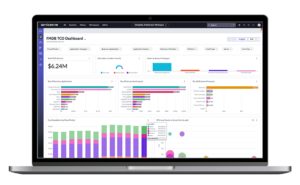We sat down with Nick Kaliszewski, Director of IT Finance at Erie Insurance, to discuss the key inflection points of his organization’s cost transparency journey with Nicus – involving targeted efforts to streamline planning, cost modeling, and reporting processes.
Over the course of our discussion, we captured not only Erie’s core challenges and how they were solved, but also the value now being delivered back to the business.
Here’s what Nick had to say…
Nicus Interviewer: Erie embarked on the cost transparency journey in 2017. What was going on in the organization back then, and what was the impetus for creating this program?
Nick: The first driver was that the ITFM team was inundated with requests around planning and forecasting for non-labor spend without understanding where the drivers were coming from. This translated into many requests being added to the plan without traceability back to the requestor and/or who entered the data into the budget. Additionally, these adds were done through an Excel file that was linked to another Excel file and then linked to a SQL database. All of this, mind you, coming from yet another Excel file on the front end.
So, we focused on cost transparency for non-labor first. We mapped all existing hardware, software, and maintenance contracts into the VEX module within Nicus. Once the initial products were established, we enabled the capability for mapping all new purchases through Nicus by way of our procurement system.
This had the benefit of not only massively reducing our planning process time, but it provided transparency into what we were spending our funding on; we took it to the level of allowing all of IT to view what each purchase is and what it’s being used for. The benefit for doing all of this was to provide transparency, hold each other accountable, and to also allow for learning across the teams on how they handle longer term contracts and upgrades.
The other driver for this program was that the IT Finance review had declined, and even the insight provided within IT was lacking. We went through a period of time when the finance support arm for IT was not gaining traction. When our team started the journey, we focused first on providing our internal partners with the support they needed, and then we had an open conversation with stakeholders to understand what information they were seeking. The business stakeholder conversations were very enlightening. The focus from executive business leaders was to better understand the work being completed and what was happening in run the business.
Nicus Interviewer: Did you choose to implement a chargeback or showback approach in your organization? How effective has it been for driving accountability?
Nick: We utilize a showback methodology in our reports, but we are not truly showing back all of the costs of IT. We report out based on how technology expenses are directly consumed. Our cost model and bill of IT provide indirect consumption, but these reports are currently reviewed with service owners and senior leaders in IT prior to roll out to the business.
We see ourselves, in the future, continuing with a showback methodology from a reporting standpoint, but creating a hybrid to chargeback. We have plans to impart our statistics for how much IT consumption comes from each cost center and then share that % with our financial reporting teams to inform their allocation process. It would act like a chargeback, but in practice it would not tie out to the same amounts seen in the bill of IT.
This may sound a little off when we are talking transparency of costs, but the reality is the only reason they would not agree is based on the cost allocation team having to follow cost allocation methods imparting shared service costs onto IT costs and then allocating out. Since we do not see those costs in any of our reports, they do not show up in the bill of IT. But at the end of the day, the statistic driving the costs out of IT would be based on the consumption of IT by all of the divisions. We are looking to model this for our reporting team as part of their allocation process updates.
Nicus Interviewer: The choice between showback and chargeback can be driven by your goals. Showback may good enough if you are simply trying to demonstrate the value of IT, but if you are really trying to drive accountability and give the customer some control over expenses, chargeback may be a better fit. Do you plan on moving to a chargeback environment in the future?
Nick: Like I said before, we do see ourselves moving toward a hybrid chargeback in the future. But to hit on this a little bit more, we already have a much-improved working relationship with our business partners after providing them with transparency of operation costs and having them at the table discussing what is happening in the development areas as well. The chargeback methodology, from our Bill of IT standpoint, does not appear to be in our future. Although who knows what the future may hold… changes in leadership, pressures from the board, or any number of things could arise and require more direct scrutiny on expenses all in.
Nicus Interviewer: Can you give some examples of real, tangible business value that you’ve been able to provide via your cost transparency program?
Nick: For us, it has truly been about three things: identifying areas of redundancy, reduced time in tracking down items, and better insight into contract negotiations.
To kick off with that first item, when we implemented our cost model and reviewed with senior leaders, they noticed an application consuming mainframe resources that they thought had been retired. It was shock for them to see this eating up MIPS, and follow-up actions taken by the Ops team were able to identify the jobs that were still processing and shut them off accordingly. It has also helped determine capacity needs as we move forward with updating the mainframe.
Next, the reduced time tracking down items comes from our monthly analysis of what is hitting certain portfolios. When we implemented Nicus, it provided every member of IT with views into the lowest level product being charged to their service/applications. Having this view gave IT owners transparency into business-driven costs for hosted software and cloud agreements. This has been powerful to enhance partnership and alignment, and it also led to cancellation of certain contracts based on previously unseen redundancy.
The third piece of business value has been related to the shift toward cloud. We’ve had two major software applications come at us with proposals on moving to the cloud, and we were able to quickly detail out the indirect and direct costs of each application in our existing environment, strengthen our understanding of true costs and cost savings, and ultimately inform negotiations and weigh options with the facts.
Final thoughts from Nick:
The key to turning data into actionable insights is getting the right info to the right persona and at the right level of detail. You need to understand what data will help that specific audience take action. Providing transparency alone isn’t enough; you need to truly understand what that persona needs to see and provide tailored insight in a consumable format. Providing too much or too little detail to the wrong person will likely cause frustration and lack of understanding, ultimately preventing decision-makers from taking action.
To stay aligned to business goals and objectives, and to continually provide value, organizations need to have processes and methodologies that are nimble. Business goals and objectives will change, and the technology to support them will change – often.
Constantly communicate with business leadership. Have frank conversations about the information and analytics that are being provided by your ITFM program and if they are providing the right insights. In other words, make sure you are focusing on value.
It is also important that you find some way to measure the results of your ITFM program either through use cases or KPIs. Metrics and data can help you to promote your ITFM program and demonstrate its value.
To learn more about Erie Insurance’s cost transparency journey, email us at .





